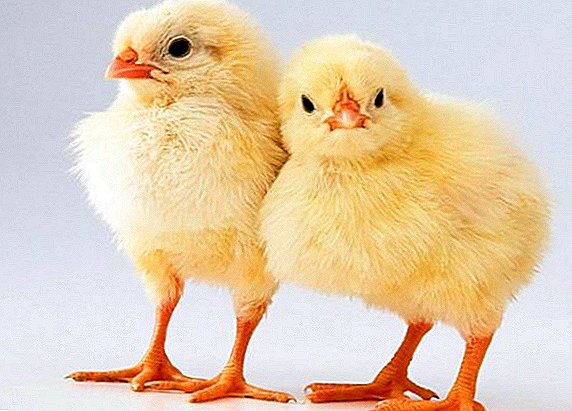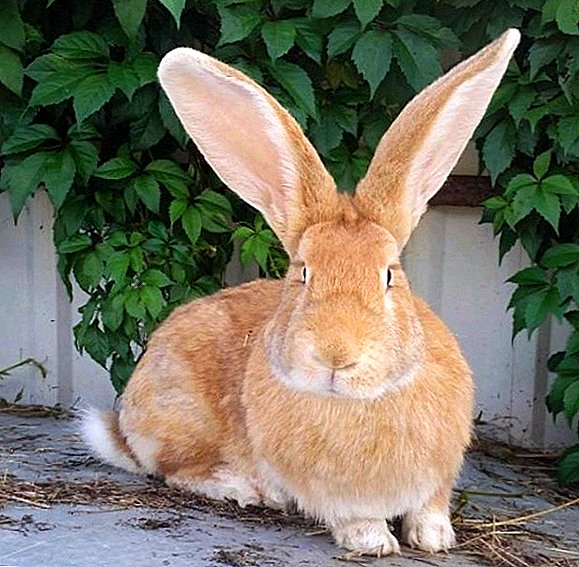 A cute pet with a formidable name has been popular with many breeders since the Middle Ages. How to choose and maintain such a purebred eared, as well as the features of breeding, read on.
A cute pet with a formidable name has been popular with many breeders since the Middle Ages. How to choose and maintain such a purebred eared, as well as the features of breeding, read on.
Breed description
That rabbits are representatives of the largest breed in the world. A large, sloping body with huge ears attracts breeders both for breeding and exhibitions, and for meat production. Pretty savvy representatives of the breed, the character is calm and friendly. A special charm adds a certain clumsiness in combination with large dimensions of the animal.
Inference history
In the XYI century, the Flanders described rabbits of enormous size and weight (up to 6 kg), noting the thick skin of high density. At that time, these rabbits were called the Belgian giants.
Like the Risen rabbits, the largest breeds of rabbits include: Viennese blue, French ram, Soviet chinchilla, giant butterfly, Belgian, white and gray giants.
In the XIX century, they came to Germany, where, thanks to the hard work of the local rabbit breeders, already in 1937 they registered a breed with the name German Giant (literal translation from German Deutsche-Riesen). 
Appearance and physique
German giants are considered to be the largest breed of rabbits in the world.
The standard characteristics of the representatives of the species are:
- weight. If we turn to history, it all began with 6 kg. Nowadays, the Risen rabbits, which weigh 9-10 kg, are not uncommon, but rather the norm. It is considered lucky if the rabbit gains up to 12 kg;
- body length From head to tail along the spine line, the length of the body of the German giants can reach 75 centimeters;
- head. Large enough. The cheeks are charmingly hanging;
- eyes. Previously, the color of the eyes of representatives of this breed was mostly red. But over time, everything changes by the strength of breeders, and in our time one can meet rizenov with brown and even blue eyes;
- ears. Usually upright, although they may fall a little to the side. This is not surprising, because the giants' ears can be up to 20 centimeters in length.
- neck. Because of the thick fur it may seem that they have no neck, but this is not so. It is usually wide and short, which is logical because of the large size of the head;
- chest. Like all parts of the body, the breast is rather big, in a girth it can be up to 42 centimeters;
- paws. Short, set wide apart and very strong. However, if they were different, they would not have sustained the weight of giants;
- okrol. Large enough - at one time a healthy rabbit can give birth to up to 12 rabbits.
Read more about how to raise rabbits for meat.
As for the slaughter output from a rabbit, the rates are very good - on average about 60%. We clarify the terminology: the slaughter weight is the weight of the carcass with a separated head and legs, without a skin and with the internal organs removed. In turn, the slaughter yield is the ratio of the slaughter weight to the living. 
Advantages and disadvantages
There are many advantages in breeding this breed:
- very tasty meat, which is used even for cooking delicious dishes;
- unlike meat of rabbits of other breeds, it has no extraneous smells, for example, the smell of grass;
- high percent of a slaughter exit, therefore - notable profitability;
- good quality of the skins, which allows to receive additional income from it;
- good performance;
- independent childbirths with which rabbit cope without problems and human participation;
- babies need breast milk only in the first week of life.
We advise you to read about why the rabbit's eyes are swollen and watery, how to help the rabbit with sun and heat stroke, what to do if the rabbit sneezes, grunts and breathes heavily, as well as how and what to treat a cold rabbits.
Yet there are disadvantages that the breeder may encounter:
- it takes at least a year to achieve maximum carcass weight for animals;
- relatively late reproductive age - females are ready for reproduction in 8 months, and males - at 12;
- Because of their size, Rizena does not like to move, which can lead to obesity;
- for the same reason they need a lot of space;
- if the person touched the newborn, the female may not take the baby.

As you can see, there are fewer disadvantages than advantages. So, knowing in advance about the possible risks and difficulties, the breeder can avoid the occurrence of the negative consequences of their actions against the German giants.
Did you know? Despite the large size and peaceful nature, rizeny did not become a popular breed for meat breeding. The long process of puberty, the unlimited growth of the carcass, the voracity and the need for space are the disadvantages that have become an advantage for rabbits. It is because of these factors that small private farms usually use them for the production of meat and wool. More often, the animal is acquired as breeding a breed or even a pet.
Maintenance and care
In order for the meat of risen to be as tasty as possible, and the fur to be soft, they need proper care and good conditions. Let's talk about this in more detail.
Selection and arrangement of cells
When choosing or building a cage, preference should be given to natural materials. The cell itself is the most sensible to make from wood. In this case, it is not only a matter of naturalness, but also of animal safety, since rabbits can get hurt about the metal bars.  The litter should be soft. Hay or straw is best for this purpose, although in the extreme case rubber can be used. Ceramic bowls can be used as feeders, but be prepared for the fact that rabbits will turn them over.
The litter should be soft. Hay or straw is best for this purpose, although in the extreme case rubber can be used. Ceramic bowls can be used as feeders, but be prepared for the fact that rabbits will turn them over.
In general, it is better to simply drink troughs and feeders at a specialty store. The most important thing when choosing a cell is space. The large rabbit will be uncomfortable in a cramped cage.
Important! Despite the fairly stable health, in particular, to viral diseases, it is necessary to strictly adhere to the rules of care.They are very similar to human ones: you need to follow the rules of hygiene, not to eat flour, to be in the open air and not to freeze. However, unlike a human being, if the rabbit is not observed, it can get sick and even die.
Conditions of detention
Rabbits love average temperature. Temperatures below -15 ° C and above +45 ° C are deadly for them. You can not put the cage in places of direct sunlight. Humidity should also not be high, it can adversely affect the quality of the litter, which means it can lead to illness of pets.
Care rules
Clean - the guarantee of health! The cage must be cleaned as it is contaminated, but not delayed with this procedure. The most important thing - the feeding trough and drinking bowl should always be absolutely clean. If the rabbit is born, grows and develops in purity - it is a guarantee that in the end you will get tasty and healthy meat, as well as a beautiful skin. 
We do prophylactic vaccinations
Immunity from the German giants is quite high. Still, experts recommend vaccination for the prevention of HBV (viral hemorrhagic disease) and myxomatosis. Vaccination for HBV should be given at the age of 1.5 and 2 months, and for myxomatosis at 2 and 2.3 months.
Risena need re-vaccination no more than 1 time in 2 years. In other standard regular vaccinations, the animal does not need.
Important! Please note: if you vaccinate animals yourself, do not forget about the precautions: be very careful and work only with gloves.
Rules of feeding and watering
Food must be balanced, as the animal is prone to obesity. The presence of vitamins and minerals is important. As for the feeding schedule, there is none as such: fill the bowls of the animal as you eat the food, but do not offer too much. 
What can
It is best to give the rabbit special factory feed. But it is important to remember that for good weight gain, the volume of feed for Rizen should be greater than for smaller breeds.
In summer and spring, you can produce fresh, but slightly dried grass and greens, and in winter - silage, hay, pine bark and cereals. You can also give depressed boiled potatoes, but only in the cooled form. Rabbits will not refuse from vegetables or fruits.
We recommend reading about whether you can give dill, corn, beets, pumpkin, peas, cabbage, pear, milk and dried milk to rabbits, and also find out how to water the rabbits, what grass to feed the rabbits.
What can not feed
Very often inexperienced breeders make a mistake, giving rizenam everything.
Here is a list of what needs to be excluded from their diet:
- bread;
- biscuit;
- baking;
- Euphorbia (grass containing toxic substances).
In their natural habitat, rabbits do not eat this, and at home it is not worth starting. 
How to water
Of course, the rabbits drink water themselves when they want. Your task is to monitor the cleanliness of the drinker and the freshness of the water. Many sources recommend the use of well water. This is due to the fact that it is natural, has no chemical impurities and is well absorbed by the body of the animal. If a well is not observed nearby, it will be enough to drink potable water.
It will be useful for you to read about how to water the rabbits with water, how to properly water the rabbits in the winter outside, and also to learn how to make a watering bowl for rabbits with your own hands.
Rearing
Sexual maturity in Rizenov comes not earlier than 8 months. This means that the first mating will be appropriate at the age of 9-12 months. 
This is a simple process:
- We remove food and water from the cage with the female, and then let the male go there.
- After 14 days, you can feel the belly of a female to confirm pregnancy.
- If the rabbit is pregnant, she must be moved to a bigger cage. The pregnancy of the German giants lasts up to 35 days.
- During childbirth, the rabbit calmly does it herself. Human participation is not necessary and even undesirable. Females have a very well developed maternal instinct, so a person will only need to monitor her proper and regular nutrition, as well as the purity of the cage.
Did you know? An interesting rabbit habit of sleeping with a face constantly in motion is not at all accidental. The fact is that an animal that is evolutionarily in the rank of a victim must always be on its guard. Shaking the tip of the nose, stirring whiskers - sensors that analyze the safety of the environment even in sleep. As soon as the situation becomes suspicious, the senses send an alarming signal to the brain, and the animal immediately wakes up.If you want to breed German giant rabbits, you need to follow quite a few rules. Then your work will be rewarded with beautiful and healthy pets.
Reviews from the network













